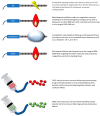Interventional Oncology and Immuno-Oncology: Current Challenges and Future Trends
- PMID: 37108507
- PMCID: PMC10138371
- DOI: 10.3390/ijms24087344
Interventional Oncology and Immuno-Oncology: Current Challenges and Future Trends
Abstract
Personalized cancer treatments help to deliver tailored and biologically driven therapies for cancer patients. Interventional oncology techniques are able to treat malignancies in a locoregional fashion, with a variety of mechanisms of action leading to tumor necrosis. Tumor destruction determines a great availability of tumor antigens that can be recognized by the immune system, potentially triggering an immune response. The advent of immunotherapy in cancer care, with the introduction of specific immune checkpoint inhibitors, has led to the investigation of the synergy of these drugs when used in combination with interventional oncology treatments. The aim of this paper is to review the most recent advances in the field of interventional oncology locoregional treatments and their interactions with immunotherapy.
Keywords: ablation; immune checkpoint inhibitors; immunotherapy; interventional oncology; personalized medicine.
Conflict of interest statement
The authors declare no conflict of interest.
Figures
Similar articles
-
Advances and Challenges in Interventional Immuno-Oncology Locoregional Therapies.J Vasc Interv Radiol. 2024 Feb;35(2):164-172. doi: 10.1016/j.jvir.2023.10.009. J Vasc Interv Radiol. 2024. PMID: 38272636 Review.
-
Immunotherapy and the Interventional Oncologist: Challenges and Opportunities-A Society of Interventional Oncology White Paper.Radiology. 2019 Jul;292(1):25-34. doi: 10.1148/radiol.2019182326. Epub 2019 Apr 23. Radiology. 2019. PMID: 31012818 Free PMC article. Review.
-
Immuno-oncology and Its Opportunities for Interventional Radiologists: Immune Checkpoint Inhibition and Potential Synergies with Interventional Oncology Procedures.J Vasc Interv Radiol. 2017 Nov;28(11):1487-1494. doi: 10.1016/j.jvir.2017.07.018. Epub 2017 Sep 12. J Vasc Interv Radiol. 2017. PMID: 28912090 Review.
-
Personalized Immuno-Oncology.Med Princ Pract. 2021;30(1):1-16. doi: 10.1159/000511107. Epub 2020 Aug 25. Med Princ Pract. 2021. PMID: 32841942 Free PMC article. Review.
-
Interventional oncology and immunotherapy: current status and future perspectives.Front Immunol. 2025 Apr 8;16:1541105. doi: 10.3389/fimmu.2025.1541105. eCollection 2025. Front Immunol. 2025. PMID: 40264767 Free PMC article. Review.
Cited by
-
Argon-helium knife cryoablation plus programmed cell death protein 1 inhibitor in the treatment of advanced soft tissue sarcomas: there is no evidence of the synergistic effects of this combination therapy.Front Oncol. 2023 Sep 5;13:1185291. doi: 10.3389/fonc.2023.1185291. eCollection 2023. Front Oncol. 2023. PMID: 37736543 Free PMC article.
-
Analysis of tumor treatment under interventional ultrasound through structural and temporal dynamics: a bibliometric visualization.Quant Imaging Med Surg. 2024 Dec 5;14(12):8899-8914. doi: 10.21037/qims-24-1233. Epub 2024 Nov 12. Quant Imaging Med Surg. 2024. PMID: 39698601 Free PMC article.
References
-
- Erinjeri J.P., Fine G.C., Adema G.J., Ahmed M., Chapiro J., Brok M.D., Duran R., Hunt S.J., Johnson D.T., Ricke J., et al. Immunotherapy and the Interventional Oncologist: Challenges and Opportunities—A Society of Interventional Oncology White Paper. Radiology. 2019;292:25–34. doi: 10.1148/radiol.2019182326. - DOI - PMC - PubMed
-
- Reig M., Forner A., Rimola J., Ferrer-Fàbrega J., Burrel M., Garcia-Criado Á., Kelley R.K., Galle P.R., Mazzaferro V., Salem R., et al. BCLC strategy for prognosis prediction and treatment recommendation Barcelona Clinic Liver Cancer (BCLC) staging system: The 2022 update. J. Hepatol. 2021;76:681–693. doi: 10.1016/j.jhep.2021.11.018. - DOI - PMC - PubMed
Publication types
MeSH terms
LinkOut - more resources
Full Text Sources
Medical


